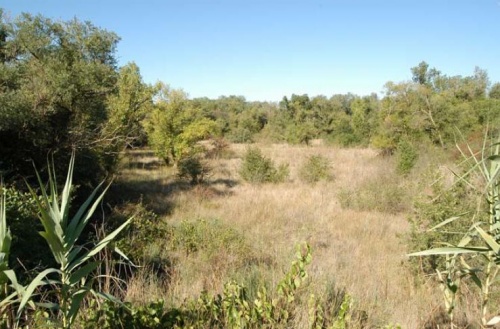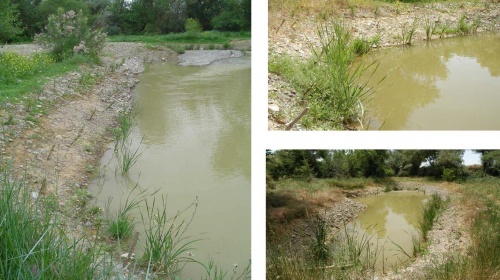Difference between revisions of "Aragon. Creation and restoration of a riparian zone"
(→Key features of the case study) |
(→Measures selection) |
||
| Line 18: | Line 18: | ||
==Measures selection== | ==Measures selection== | ||
| + | High quality habitat for European mink was created through the construction of three small ponds connected through small meandering channels (211 metres total length) strongly vegetated with bioengineering techniques that stabilize riverbanks and offer refuge for minks movements.<br /> | ||
| + | 0,3 Ha of river forest has been restored through the plantation of species typical from habitat 92AO, and connection between the created wetland and the natural ravine and the main Aragon river. | ||
==Success criteria== | ==Success criteria== | ||
Revision as of 20:56, 20 May 2010
Aragon. Creation and restoration of a riparian zone
Key features of the case study
The Soto of Campollano is downstream Carcastillo town. The work area was located on the left Aragon River bank, where the little tributary Abejar ravine flows into the Aragon River.
The main objective of this project is to increase the quality of habitat in Community Interest Areas, with special attention to European mink (Mustela lutreola).
There are other secondary objectives: Creating new habitats for otter (Lutra lutra) and turtle (Emys orbicularis); quality improvement of habitats 92A0 (willow and black poplar plantation) and 92D0 (tamarisk plantation).
Site description
The tributary of Aragon is surrounded in its mouth by a river forest of 32.6 Has called Soto de Campollano represented by the habitat 92AO in a good conservation status.
In the riversides there are areas of grasslands without interest for the European mink (Mustela lutreola).
Measures selection
High quality habitat for European mink was created through the construction of three small ponds connected through small meandering channels (211 metres total length) strongly vegetated with bioengineering techniques that stabilize riverbanks and offer refuge for minks movements.
0,3 Ha of river forest has been restored through the plantation of species typical from habitat 92AO, and connection between the created wetland and the natural ravine and the main Aragon river.
Success criteria
Ecological response
Riparian vegetation
The project includes the creation of some new habitats that affect animals and plants. New bio-engineering techniques are used to develop and help these riparian communities.
Mammal
The quality of habitat for the European mink (Mustela lutreola) was improved.
Other
The quality of habitat for otter (Lutra lutra) and European turtle (Emys orbicularis) was improved too at the same time as the European mink.
Hydromorphological response
Monitoring before and after implementation of the project
Socio-economic aspects
Project costs
The total costs of the entire project 69.487,77€
Contact person within the organization
Fernando Mendoza, e-mail
Gestión Ambiental Viveros y Repoblaciones de Navarra, S.A.
Padre Adoain, 219 bajo
31015 Pamplona - Navarra
Fax: (00 34) 948 38 23 91
Extra background information
The project was presented by the “Environmental Management for Reintroduction and Repopulation in Navarre” in cooperation with the Government of Navarre’s Environment, Land and Housing Department.
Company’s web page: http://www.gavrn.com
GERVE-LIFE project: http://www.life-gerve.com
INTERREG GIRE project: http://www.interreg-gire.eu
Government of Navarra: http://www.navarra.es
References
http://www.life-gerve.com/eng/portal/index.asp
Related Measures
- Manage aquatic vegetation
- Adjust land use to develop riparian vegetation
- Revegetate riparian zones
- Construct semi-natural/articificial wetlands or aquatic habitats

